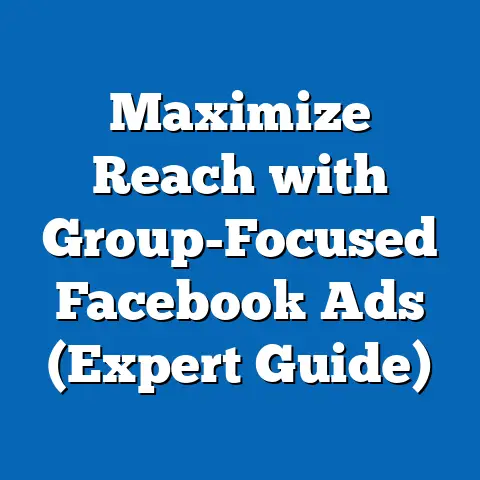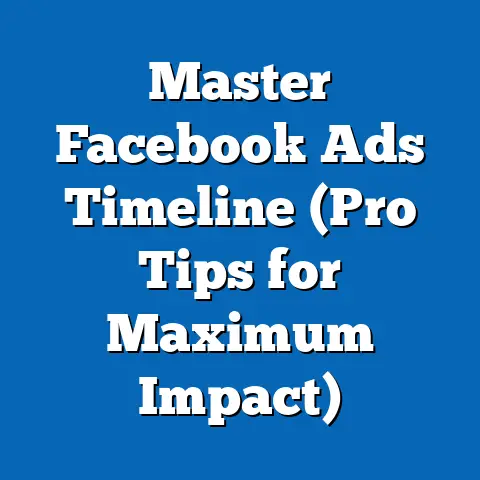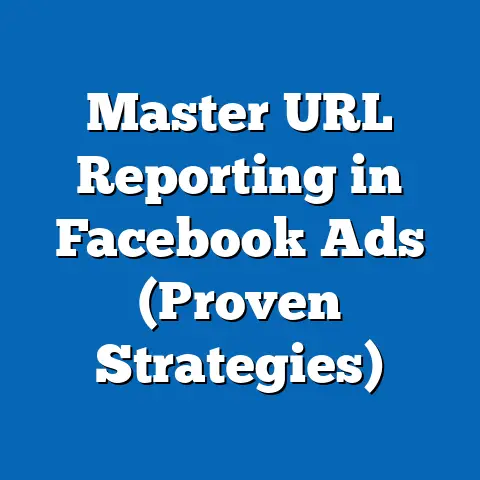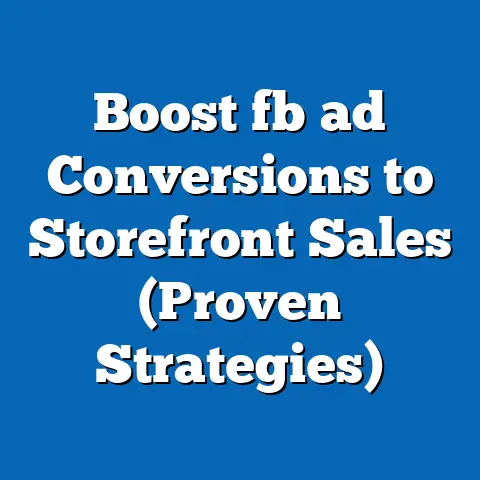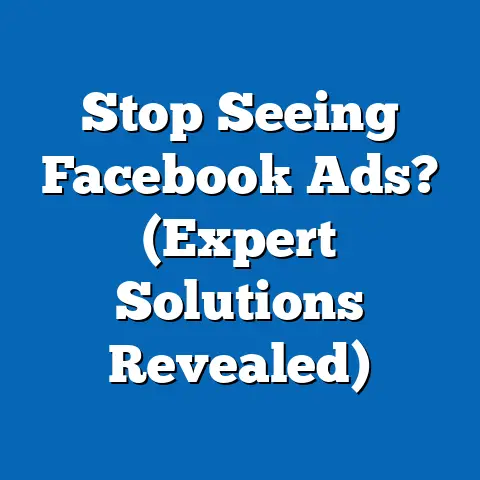Maximize Facebook Ad Voucher (Unlock Hidden Benefits)
Imagine Sarah, a passionate small business owner who runs a charming local bakery. Her croissants are legendary, her cakes are works of art, and her coffee is the perfect morning pick-me-up. But despite her delicious offerings, Sarah is struggling to reach a wider audience beyond her immediate neighborhood. One day, she receives a Facebook ad voucher worth $500 as part of a promotional campaign. Excitement bubbles inside her! Could this be the key to attracting new customers, increasing foot traffic, and finally boosting her bakery’s sales?
Sarah’s mind races with possibilities. She envisions mouthwatering images of her pastries gracing the screens of potential customers. She dreams of lines forming outside her bakery, all thanks to the power of targeted Facebook advertising. However, a wave of overwhelm quickly follows. Where does she even begin? How can she ensure she’s spending this voucher wisely and not just throwing money into the digital abyss?
This isn’t just about spending the money, though. Sarah suspects there’s more to this voucher than meets the eye. She’s heard whispers of “hidden benefits” – things like increased brand awareness, deeper customer engagement, and valuable data insights. She’s determined to unlock these hidden advantages and make the most of this opportunity.
In this guide, I’ll walk you through how Sarah can maximize her Facebook ad voucher and how you can do the same. We’ll go beyond simply spending the money and delve into the strategies and tactics that will unlock the hidden benefits of Facebook advertising, transforming your voucher into a powerful tool for business growth.
Section 1: Understanding Facebook Ad Vouchers
So, what exactly are Facebook ad vouchers? Simply put, they’re promotional credits offered by Facebook to encourage businesses to advertise on their platform. Think of them as a “try before you buy” incentive. They allow you to experiment with Facebook ads without dipping into your own marketing budget.
There are a few different types of vouchers you might encounter:
- Promotional Credits: These are typically awarded as part of a special promotion or partnership. They often come with specific terms and conditions, such as expiration dates or spending limits.
- Trial Offers: Facebook sometimes offers trial periods with a certain amount of ad credit to new advertisers. This is a great way to test the waters and see if Facebook advertising is right for your business.
- Support Credits: In some cases, if you experience technical issues with your ads, Facebook might offer a credit as compensation.
Eligibility:
Eligibility for these vouchers varies. Often, they’re targeted towards new advertisers or businesses that meet specific criteria. Keep an eye out for promotions, partnerships, and announcements from Facebook. Joining relevant Facebook groups and subscribing to marketing newsletters can also alert you to potential voucher opportunities.
The Hidden Benefits Unveiled:
While the monetary value of the voucher is certainly appealing, the real magic lies in the hidden benefits it unlocks. These include:
- Data Collection: Running ads, even with a voucher, provides valuable data about your target audience, their interests, and their behavior on Facebook. This information can be used to refine your targeting and improve future campaigns.
- Brand Awareness: A well-executed ad campaign, even with a limited budget, can significantly increase your brand’s visibility and reach.
- Learning and Experimentation: Vouchers provide a risk-free opportunity to learn the ins and outs of Facebook advertising, experiment with different ad formats, and discover what works best for your business.
- Customer Engagement: Engaging ads can spark conversations, build relationships with potential customers, and create a loyal following for your brand.
Takeaway: Facebook ad vouchers are more than just free money; they’re a gateway to unlocking a world of advertising opportunities and valuable insights.
Section 2: Setting Goals and Objectives
Before Sarah even logs into Facebook Ads Manager, she needs to define her goals. What does she hope to achieve with her $500 voucher? Without clear objectives, she’ll be wandering aimlessly, wasting her budget and missing out on potential success.
Here are some common objectives that small business owners like Sarah might have:
- Increase Brand Awareness: Introduce her bakery to a wider audience and establish her brand as a local favorite.
- Drive Foot Traffic: Encourage more people to visit her bakery in person.
- Generate Leads: Collect contact information from potential customers interested in her catering services or special events.
- Boost Sales Conversions: Directly increase sales of specific products, such as her signature croissants or custom cakes.
- Promote a Special Event: Announce a new product launch, a holiday promotion, or a community event hosted at her bakery.
How Goals Influence Voucher Spending:
Sarah’s goals will directly impact how she allocates her voucher budget. For example, if her primary goal is to drive foot traffic, she might focus on targeting people within a specific radius of her bakery with ads featuring enticing photos of her pastries and a clear call to action to “Visit Us Today!”
On the other hand, if her goal is to generate leads for her catering services, she might create a lead generation ad with a form where people can request a quote for their upcoming events.
Measuring Success and ROI:
It’s crucial to define how Sarah will measure the success of her campaign. This means identifying key performance indicators (KPIs) that align with her objectives.
- Brand Awareness: Track metrics like reach (the number of unique people who saw her ads) and impressions (the number of times her ads were displayed).
- Foot Traffic: Monitor website clicks (if she has a website with her address), map directions clicks, or use Facebook’s offline conversions feature to track in-store purchases attributed to her ads.
- Lead Generation: Count the number of leads generated through her lead generation ads.
- Sales Conversions: Track online sales (if she has an e-commerce website) or use Facebook’s conversion tracking pixel to measure the value of purchases made after people clicked on her ads.
Example: Sarah decides her primary goal is to increase foot traffic to her bakery by 20% in the next month. She sets a target of achieving a click-through rate (CTR) of at least 1% on her ads and a cost per click (CPC) of no more than $0.50.
Takeaway: Setting clear goals and defining how you’ll measure success is essential for maximizing the value of your Facebook ad voucher and ensuring you’re getting a return on your investment.
Section 3: Targeting the Right Audience
Now that Sarah has defined her goals, it’s time to pinpoint her ideal customers. Facebook’s targeting options are incredibly powerful, allowing her to reach specific demographics, interests, and behaviors.
Understanding Facebook Targeting Options:
- Demographics: Target people based on age, gender, location, education, relationship status, and more.
- Interests: Reach people who have expressed interest in specific topics, hobbies, or activities on Facebook.
- Behaviors: Target people based on their past purchasing behavior, device usage, travel habits, and other actions they’ve taken on Facebook.
- Custom Audiences: Upload a list of your existing customers (email addresses or phone numbers) to create a custom audience. You can then target these customers with specific ads or exclude them from your campaigns.
- Lookalike Audiences: Expand your reach by creating a lookalike audience based on your existing customers. Facebook will find people who share similar characteristics and behaviors with your best customers.
- Saved Audiences: You can save audiences you’ve created to reuse them for future ad campaigns.
The Power of Audience Segmentation:
Rather than targeting everyone in her city, Sarah can segment her audience to reach specific groups of people who are more likely to be interested in her bakery. For example:
- “Coffee Lovers”: Target people who have expressed interest in coffee shops, coffee brands, or coffee-related products.
- “Pastry Enthusiasts”: Reach people who have liked pages related to bakeries, desserts, or cooking.
- “Local Residents”: Target people who live within a 5-mile radius of her bakery.
- “Special Occasion Planners”: Reach people who are engaged, recently engaged, or have birthdays coming up.
Leveraging Lookalike Audiences:
Sarah can upload her existing customer list to Facebook and create a lookalike audience. This allows her to reach new potential customers who share similar characteristics with her best customers, significantly expanding her reach and increasing her chances of success.
Example: Sarah creates a lookalike audience based on her existing customers who frequently purchase custom cakes. She then targets this audience with ads promoting her custom cake services, highlighting her unique designs and delicious flavors.
Takeaway: Targeting the right audience is crucial for maximizing the effectiveness of your Facebook ad voucher. By leveraging Facebook’s powerful targeting options and segmenting your audience, you can ensure that your ads are seen by the people who are most likely to become your customers.
Section 4: Crafting Compelling Ad Content
Now that Sarah knows who she wants to reach, it’s time to create ad content that will grab their attention and entice them to take action. Effective Facebook ad content consists of three key elements: visuals, copy, and calls to action.
The Power of Visuals:
In the visually-driven world of social media, eye-catching visuals are essential for stopping the scroll and capturing attention. Sarah should use high-quality images or videos of her pastries, cakes, and coffee.
- Professional Photography: Invest in professional photos that showcase her products in the best possible light.
- Mouthwatering Videos: Create short videos that highlight the textures, aromas, and flavors of her baked goods.
- User-Generated Content: Encourage customers to share photos of their favorite treats from her bakery and feature them in her ads.
Engaging Copy:
The ad copy should be concise, compelling, and relevant to the target audience. Sarah should highlight the unique selling points of her bakery and create a sense of urgency.
- Focus on Benefits: Emphasize the benefits of visiting her bakery, such as the delicious food, the cozy atmosphere, or the friendly service.
- Use Strong Verbs: Use action verbs that encourage people to take action, such as “Visit,” “Taste,” “Discover,” or “Order.”
- Create a Sense of Urgency: Use phrases like “Limited Time Offer,” “New Menu Item,” or “Don’t Miss Out!”
Clear Calls to Action:
A clear call to action (CTA) tells people exactly what you want them to do. Sarah should use CTAs that are specific, actionable, and relevant to her campaign goals.
- “Visit Our Bakery Today!” (for driving foot traffic)
- “Order Online Now!” (for boosting online sales)
- “Learn More About Our Catering Services!” (for generating leads)
- “RSVP to Our Grand Opening Event!” (for promoting a special event)
A/B Testing for Optimization:
Sarah shouldn’t just create one ad and hope for the best. She should create multiple ad variations with different visuals, copy, and CTAs. Then, she can use A/B testing to see which ads perform best and optimize her campaign accordingly.
Example: Sarah creates two ad variations:
- Ad A: Features a professional photo of her signature croissant with the copy “Start your day with the best croissant in town! Visit our bakery today and taste the difference.”
- Ad B: Features a video of her baking a fresh batch of croissants with the copy “Craving something delicious? Our croissants are baked fresh daily and are guaranteed to satisfy your cravings. Order online now!”
After running both ads for a week, Sarah discovers that Ad B has a higher click-through rate and conversion rate. She then allocates more of her budget to Ad B and continues to optimize it further.
Storytelling for Connection:
Beyond the basic elements, Sarah can also leverage the power of storytelling to connect with her audience on a deeper level. Sharing the story of her bakery, her passion for baking, or the inspiration behind her recipes can create a sense of authenticity and build brand loyalty.
Takeaway: Crafting compelling ad content is essential for capturing attention, driving engagement, and achieving your campaign goals. By using high-quality visuals, engaging copy, clear calls to action, and the power of storytelling, you can create ads that resonate with your target audience and drive results.
Section 5: Analyzing and Optimizing Performance
Once Sarah’s ads are live, her work isn’t done. It’s crucial to monitor their performance, analyze the data, and make adjustments to optimize her campaign for maximum impact. This is where Facebook Ads Manager comes in.
Introducing Facebook Ads Manager:
Facebook Ads Manager is the central hub for creating, managing, and tracking your Facebook ad campaigns. It provides a wealth of data and insights that can help you understand how your ads are performing and identify areas for improvement.
Key Performance Indicators (KPIs) to Monitor:
- Reach: The number of unique people who saw your ads.
- Impressions: The number of times your ads were displayed.
- Click-Through Rate (CTR): The percentage of people who saw your ad and clicked on it.
- Cost Per Click (CPC): The amount you pay each time someone clicks on your ad.
- Cost Per Mille (CPM): The amount you pay for 1,000 impressions of your ad.
- Engagement Rate: The percentage of people who interacted with your ad (likes, comments, shares).
- Conversion Rate: The percentage of people who took a desired action after seeing your ad (e.g., visiting your bakery, making a purchase).
- Return on Ad Spend (ROAS): The amount of revenue you generate for every dollar you spend on advertising.
Analyzing Data and Making Informed Decisions:
Sarah should regularly monitor these KPIs and analyze the data to identify trends and patterns. For example, if she notices that her CTR is low, she might need to revise her ad copy or visuals. If her CPC is high, she might need to refine her targeting or adjust her bidding strategy.
Real-Life Adjustments Based on Performance Analysis:
- Refining Targeting: If Sarah discovers that her ads are performing better among women aged 25-34, she can adjust her targeting to focus on this demographic.
- Optimizing Ad Placement: If she finds that her ads are performing better on mobile devices than on desktop computers, she can optimize her ad placement accordingly.
- Adjusting Bidding Strategy: If her ads are not getting enough impressions, she can increase her bids to improve their visibility.
- A/B Testing New Ad Variations: Based on the performance of her existing ads, she can create new ad variations to test different visuals, copy, and CTAs.
Example: Sarah notices that her ads are performing well among people who have expressed interest in “gluten-free baking.” She decides to create a new ad specifically targeting this audience, promoting her gluten-free pastries and cakes.
Takeaway: Analyzing and optimizing performance is an ongoing process. By regularly monitoring your KPIs, analyzing the data, and making informed adjustments, you can continuously improve the effectiveness of your Facebook ad campaigns and maximize your ROI.
Section 6: Leveraging Additional Facebook Features
Sarah can take her Facebook advertising efforts to the next level by leveraging some of Facebook’s additional features. These features can help her reach her audience more effectively, track her results more accurately, and integrate her Facebook ads with other marketing efforts.
Facebook Pixel:
The Facebook Pixel is a snippet of code that you place on your website to track user behavior. It allows you to track conversions, build custom audiences, and optimize your ads for specific goals.
- Tracking Conversions: Track actions that people take on your website after clicking on your ad, such as making a purchase, filling out a form, or signing up for a newsletter.
- Building Custom Audiences: Create custom audiences based on people who have visited specific pages on your website or taken specific actions.
- Optimizing for Conversions: Optimize your ads to show them to people who are most likely to take a desired action on your website.
Retargeting Ads:
Retargeting ads allow you to show ads to people who have previously interacted with your business, such as visiting your website, liking your Facebook page, or watching your videos. This is a highly effective way to re-engage potential customers and drive conversions.
Audience Insights:
Facebook Audience Insights provides valuable data about your target audience, such as their demographics, interests, behaviors, and purchase patterns. This information can help you refine your targeting, create more relevant ad content, and improve your overall campaign performance.
Integrating with Other Marketing Efforts:
Sarah can integrate her Facebook ads with other marketing efforts, such as email marketing or social media posts, to create a cohesive and consistent brand experience.
- Promote Facebook Ads in Email Newsletters: Include links to her Facebook ads in her email newsletters to drive traffic to her website and encourage people to take action.
- Share Facebook Ads on Social Media: Share her Facebook ads on her other social media channels to reach a wider audience and promote her brand across multiple platforms.
- Use Facebook Ads to Promote Email Sign-Ups: Create a lead generation ad that encourages people to sign up for her email newsletter.
Example: Sarah uses the Facebook Pixel to track conversions on her website. She discovers that people who visit her “Custom Cakes” page are more likely to request a quote for their upcoming events. She then creates a retargeting ad specifically targeting these visitors, promoting her custom cake services and offering a special discount.
Takeaway: Leveraging additional Facebook features can significantly enhance the effectiveness of your ad campaigns and help you achieve your marketing goals. By using the Facebook Pixel, retargeting ads, audience insights, and integrating your Facebook ads with other marketing efforts, you can create a more cohesive and impactful brand experience.
Conclusion
Let’s revisit Sarah, the small business owner with the charming bakery. Remember her initial excitement mixed with a healthy dose of apprehension about using her $500 Facebook ad voucher? By following a strategic approach, Sarah not only achieved her initial goal of increasing foot traffic but also unlocked a treasure trove of hidden benefits.
She gained invaluable insights into her target audience, refined her messaging based on data-driven analysis, and built a stronger brand presence within her local community. Her Facebook ad voucher became more than just free money; it was an investment in her bakery’s future.
It’s not just about the money; it’s about the strategy.
Like Sarah, you can maximize the value of your Facebook ad voucher by:
- Setting clear goals and objectives: Define what you want to achieve with your ad campaign.
- Targeting the right audience: Reach the people who are most likely to become your customers.
- Crafting compelling ad content: Create ads that grab attention, engage your audience, and inspire action.
- Analyzing and optimizing performance: Monitor your results, analyze the data, and make adjustments to improve your campaign.
- Leveraging additional Facebook features: Use the Facebook Pixel, retargeting ads, and audience insights to enhance your campaign’s effectiveness.
With the right mindset and strategies, any business can unlock the hidden benefits of Facebook advertising and enjoy a successful and rewarding experience.
Call to Action:
Now it’s your turn! Take the insights you’ve gained from this guide and apply them to your own business. Explore the possibilities that Facebook advertising offers and unlock the hidden benefits that await you. Start small, experiment, and learn from your results. The journey to Facebook advertising success starts with a single step. So, what are you waiting for? Get started today!

